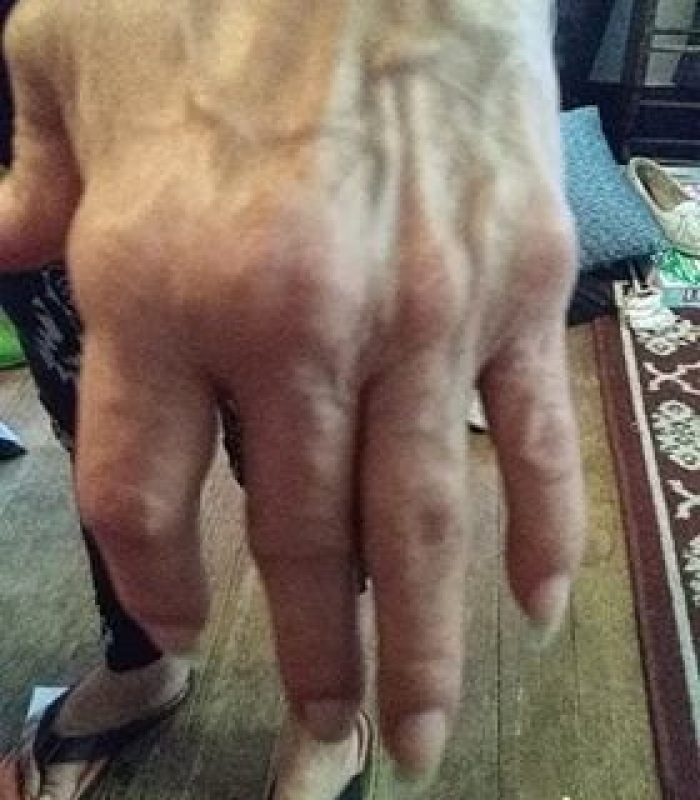Even though I live in an illegal region, cannabis is worth it for my rotator cuff injury.
Editor’s Note: Any testimonials or endorsements found on this site are for anecdotal purposes only. The information in RxLeaf testimonials is not intended as direct medical advice, nor should it be relied upon as a substitute for consultations with qualified healthcare professionals who are intimately knowledgeable about your individual medical needs.
My name is Lawrence and I started using cannabis after my rotator cuff injury. It happened while I was working as a contractor for the federal government. I needed surgery and my doc told me not to go back to that work (digging, setting forms, and pouring/finishing concrete) for at least one year.
Fresh out of surgery, I had a pain ball taped to my chest about the size of a baseball. That ball is actually a surgical tube filled with pain medication that drips the medication into my shoulder by a small plastic tube. After a few days the doctor took it out and gave me Percocet. And then he gave me a year’s prescription of Percocet.
It worked great for the pain but the side effects were terrible – started itching all the time. Then I started getting the shakes. I also had no appetite. This “perfect drug” was taking a toll on my body.
So I Turned to Cannabis…
With cannabis, I started to give a crap about things again, and the pain was almost gone. I felt it just enough to remind me not to use my recovering arm.
Back then I was living in a state that threw possessors of a single roach or seed into prison. So, I can’t tell you which strain I took, but it was good, and grew fairly densely under my newly purchased 400W grow light. It was an early purple turner.
What works best for my pain was using a water bong.
I now use cannabis to slow down and think, it stops my heart palpitations and after 40 years working in the construction field, it helps with this miserable CMC pain.
The RxLeaf Angle – Cannabis for a Rotator Cuff Injury?
There’s a lot of science going on behind Lawrence’s recovery from a rotator cuff injury. The cessation of Percocet side effects, the pain relief from cannabis, the purple tint of his weed, his use of a water bong, and the heart palpitations, and the easing of CMC pain all have valid scientific explanations that allow scientists to understood exactly why weed has benefitted Lawrence.
How Cannabis Treated a Rotator Cuff Injury
Cannabis doesn’t always leap to mind for sports work wounds such as a rotator cuff injury. Most often, people think of it as helpful for everyday pains, like headaches or arthritis. But professional athletes are among cannabis’ most ardent supporters thanks to the benefits the plant provides to exercise recovery and performance-related injuries.
A rotator cuff injury refers specifically to tears in the tendons surrounding the shoulder joint. It usually happens in people who repeatedly perform the same shoulder motion, such as hoisting heavy boxes or hurling a baseball. However, sometimes a single over-exertion can cause the tendons connecting the shoulder joint and surrounding muscles to rip. Cannabis helps by reducing inflammation in the joint caused by the rupture.
Unfortunately, Lawrence needed surgery because his injury was so severe. The doctors sought to ease his pain through a medicinal drip and a year of Percocet — with disastrous consequences. We know well the side effects of opioids, but doctors in states without legal cannabis don’t have many other options. This even though cannabis has been shown to help reduce the side effects of opioids and can help prevent addiction. Replacing opioids with cannabis, for many people, is a way to take back their lives and livelihoods while still reaping the benefits of pain medicine.
Why a Water Bong Works
There’s a lot of research that explains why Lawrence used a water bong for his rotator cuff injury.
Each method of consumption changes how cannabis interacts with the body. Scientist refer to the rate of absorption and processing of cannabis as its “bioavailability.” And whether it’s eaten, smoked, absorbed sublingually, or applied topically, the bioavailability of cannabis creates different effects depending on how it’s used.
While some people with a rotator cuff injury may find initial relief from topical ointments, Lawrence opted for the inhalation. Using a water bong meant Lawrence found near-instant relief, as smoking has the highest bioavailability and produces the fastest onset of effects. A bong also allows a large dose of cannabis to administered at once while filtering out some of the harmful irritants of the smoke.
The CMC Pain
Lawrence also mentioned the CMC (carpometacarpal) pain from his decades of construction work.
CMC refers to arthritis that happens at the base of the thumb, where it connects to the wrist. Sufferers know how frustratingly painful it is — and how useless most common drugs are at helping.
But no less than the Arthritis Foundation itself has endorsed cannabis as a means to combat that kind of pain. Lawrence is effectively getting a two-for-one deal when he hits the water bong. He lessens the pain of his rotator cuff injury and makes the arthritis in his hand manageable.
That’s the power of cannabis.







